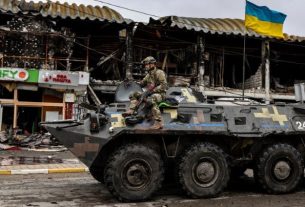Britain’s Defense Ministry said Sunday in its daily intelligence report about Ukraine that there has been a “series of dismissals of senior Russian military commanders since the onset of the invasion in February 2022.”
The report said, “These dismissals represent a pattern of blame against senior Russian military commanders for failures to achieve Russian objectives on the battlefield. This is in part likely an attempt to insulate and deflect blame from Russian senior leadership at home.”
Heavy fighting and explosions were reported Saturday by authorities in Ukraine’s southern Kherson region.
Over the previous 24 hours Ukrainian forces attacked nine locations, including an ammunition depot in the Kherson region, using Russian military equipment that they had seized.
“[Ukrainian forces] prepare for another stage of an offensive on the Kherson Region. Artillery brigade groups, mortar batteries, tactical aviation planes and army aviation helicopters inflict massive fire within their preparation for an assault,” the Moscow-installed Deputy Governor Kirill Stremousov said on his Telegram channel Saturday.
Russia continues to target the country’s energy and water infrastructure, reportedly destroying 30% to 40% of its energy system, leading to increased rolling blackouts meant to protect the county’s power grid from failing.
Meanwhile, external power lines have been repaired and reconnected to Ukraine’s Zaporizhzhia nuclear power plant two days after it was taken off the power grid when Russian shelling damaged high voltage lines, the International Atomic Energy agency said Saturday.
IAEA Director General Rafael Mariano Grossi again called for a nuclear safety and security protection zone to be set up around the plant to prevent a nuclear accident.
“We can’t afford to lose any more time. We must act before it is too late,” he said.
Russia is increasing its evacuation of residents from the conflict zone and acknowledging the deteriorating situation in the Kherson region. At least 70,000 civilians have been moved from Kherson, the only regional capital captured by Moscow since February.
Pro-Kremlin media members have reported that Russian troops have moved their headquarters 80 kilometers to the southeast, destroying infrastructure and looting the city as they leave, residents and Ukrainian officials said, according to The New York Times.
While a bloody battle for the city is predicted, the “situation in Kherson is clear as mud,” Michael Kofman, the director of Russian studies at CNA, a research institute in Arlington, Virgina, wrote in an analysis this week, the Times reported. “Russian forces seemed to withdraw from some parts, evacuated and drew down, but also reinforced with mobilized personnel.”
Residents of the city report abandoned checkpoints and no more Russian patrols, but Ukrainian officials are cautious, believing Moscow is setting a trap.
In its intelligence update Saturday, however, the British defense ministry said that “Russia is probably struggling to provide military training for its current mobilization drive and its annual autumn conscription intake. The Russian Armed Forces were already stretched providing training for the approximate 300,000 troops required for its partial mobilization, announced in September.
“These issues,” the ministry said, “will be compounded by the additional regular autumn annual conscription cycle” that begins in November for about 120,000 conscripts.
Russia has resorted to training troops in Belarus, the ministry said, “due to a shortage of training staff, munitions and facilities in Russia.” The intelligence update said that “deploying forces with little or no training provides little additional offensive combat capability.”
Iranian drones
Iranian Foreign Minister Hossein Amir Abdollahian admitted for the first time Saturday that Iran sent drones to Russia, but he said that was before the Russian invasion of Ukraine, where Russia has been using drones to target power stations and civilian infrastructure.
However, in a video address, President Volodymyr Zelenskyy dismissed Iran’s admission of providing only a limited number of drones to Russia before the war on Ukraine. He said Ukrainian forces are downing at least 10 or the unmanned aerial vehicles daily.
The U.S. and its Western allies on the U.N. Security Council have called on Secretary-General Antonio Guterres to investigate whether Russia has used Iranian drones to attack civilians in Ukraine.
Meanwhile, the U.S. is providing about $400 million in additional security assistance to Ukraine as the fight against Russia’s invasion enters its ninth month.
The U.S. military assistance includes refurbishing HAWK air defense missiles, funding for 45 refurbished T-72B tanks with advanced optics, communications, and armor packages, 1,100 Phoenix Ghost tactical unmanned aerial systems, 40 armored riverine command boats, funding to refurbish 250 M1117 armored security vehicles, as well as tactical secure communications systems and surveillance systems, along with funding for training, maintenance, and sustainment.
In his nightly address Friday, Zelenskyy thanked the United States for its latest military assistance and said it is the armored vehicles in particular that “we very much need to move forward at the front.”
“I am grateful to President Biden, the U.S. Congress and the entire American people for the continued and vital assistance,” he said.__VOANews





